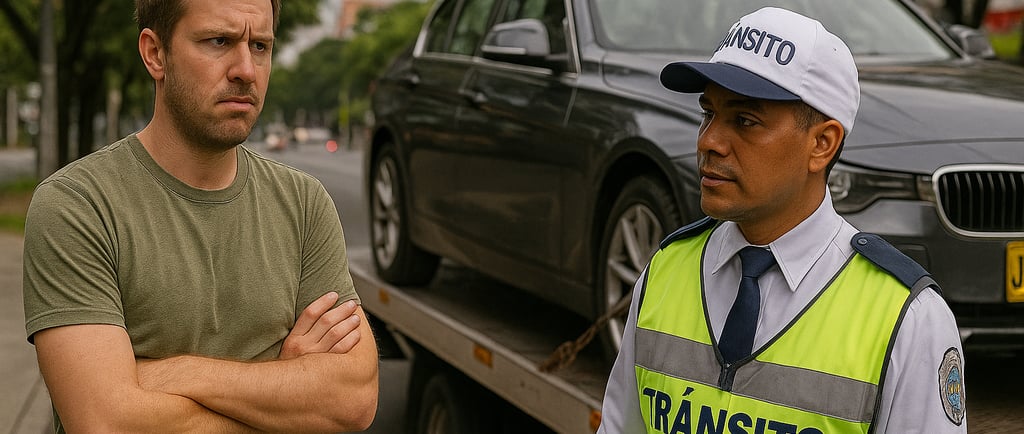Subscribe to our youtube channel today! @medellin_unfiltered
Buying a Car in Colombia in 2026 — The Brutally Honest Guide
Thinking about buying a car in Colombia? Here’s a first-hand 2026 guide that covers the reality; real prices, red tape, SOAT, Pico y Placa, and the headaches you don’t see on expat forums.
FEATUREEXPATS
Steve Hamilton
10/22/20257 min read


Buying a Car in Colombia in 2025
tl;dr 🚗
💸 Cars cost more in Colombia because of import taxes and dealer markups.
🧾 You must have active SOAT and a technical inspection after their fifth year.
🏦 Cash or certified bank transfer is the safest way to close a deal.
🔌 Electric cars are rising fast, but charging stations still lag behind.
🛣️ Medellín’s traffic and parking rules can make or break your decision.
Buying a Car in Colombia in 2025
When I moved here, back in 2015, I didn't know what to expect. Sure, I had travelled here many times before taking the plunge, but, I didn't know the rhythm of life, and one of those things was I thought I was going to buy a car. In the US, particularly in California, where I'm from, if you don't have a car your life is greatly impacted. A car means freedom, the ability to go where you want, when you want. When I got here I pivoted because I didn't need one.
That is until the woman I was dating at the time wanted to get a car so I could be her chauffeur. I didn't want to get a car, she wanted to get a car so we compromised - and bought a car. She wanted to get something nice, and something that would be safe for us to drive to visit her family in Bogota. We landed on an Audi Q3, which I must admit was a fantastic car. It was peppy, efficient, great looking and handled rainy downpours on the Autopista on the way to Bogota nicely. We bought it new, and I wasn't prepared for the level of red tape that meant.
The first is the cost. Cars cost so much more here, just remember that all cars are imported here. There is no automotive industry in Colombia, so all cars come from Japan, Europe or the US. If you are fancy like my ex and I were be prepared to pay much more for a car than you would in any of those places. We spent the equivalent of $55,000 USD on that car, when the same car in the US is $41k.
Then there is maintenance, much of our maintenance was covered with the Audi/VW warranty, but if something goes wrong, we were in alot of trouble. Here is the thing, I was a mechanic once upon a time, I know how to work on cars, but I would need the tools and the place to do so, and I had neither.
The next is the SOAT and insurance. SOAT, I'll explain below, but the insurance is incredibly expensive here. Driving in big cities like Medellin, Cali or Medellin is not the safest from the perspective of keeping your car free from accidents, and if you are not accustomed to driving here, the risk is 10x. Driving in Medellin is an adventure at best, panic inducing at worst. Driving in Bogotá is another level, if you think driving here is rough, the capital city brings the heat. Because of this insurance is very expensive here.
The other part is that you have to look at why you think you need a car. With all of our great thoughts, we drove it to Bogota 2 times, and to Pereira once. In 2 years of owning the car, we put a total of 25k km on it. That is about 10k miles. We drove it all around town when we first bought it, but in all honesty, it became more of a hassle than it was worth, but our lifestyle wasn't conducive to needing a car. Deeply think about whether you need a car. Life in Medellin for most doesn't require a car. We from the US are programmed to thinking that we need a car to survive, but the truth is that the public transportation options are fantastic here and there is Uber, DiDi, InDrive, Yango and Taxis if you're intimidated by the public transit.
Here is a breakdown of the experience in Colombia:
1. Why You Might Want a Car in Colombia
Public transport works fine until it doesn’t. Maybe you want flexibility for weekend trips to Guatapé or San Rafael. Ride sharing prices are climbing, and rural travel is awkward without your own wheels. Busses are an option, but in all honesty, there are many people who are afraid of busses, I don't understand why, but they are. As I said, car prices here shock most newcomers. Expect 20–40 percent higher costs than in North America or Europe for the same model. My example is I owned a Mini Cooper S in the US before I moved here, I loved that car, but when I sold it, I got $4500 for it. The exact same car here on TuCarro is $7500 - with higher mileage and without as many amenities as my car had. That’s import duty, VAT, dealer margins, and limited competition.
2. New vs Used
Used cars dominate the Colombian market. Most are sold through platforms like OLX Autos, Tucarro, or dealer lots along Avenida Guayabal or the Auto mall on Calle 23 and Avenida Poblado. While buying used is the way to go, you have to be WAY more diligent than you are in the US when buying used cars in the US.
Always: Check the tarjeta de propiedad (ownership card). Confirm the seller and vehicle are both listed in RUNT (national transit database). Run the plate through SIMIT to verify no fines or unpaid taxes. Look for a valid revisión técnico-mecánica (inspection) if the car is over five years old. If you don't know cars well, get a pre-purchase inspection from a reputable mechanic, because there are scams everywhere, and there are limited consumer protection laws here. New cars from dealers like Mazda, Toyota, and Renault come with SOAT and registration help. Just know you’ll pay extra for that convenience, I certainly know this one.
3. The 2025 Buying Process Step-by-Step
Choose your car.
Verify documents and mechanical condition.
Negotiate final price — always ask for a discount.
Obtain or renew SOAT (2025 rates start around COP 445,000 for small sedans).
Pay local taxes (impuesto vehicular) and transfer fees.
Register ownership at your city’s Secretaría de Movilidad.
Keep digital and paper copies of everything — traffic police can ask for proof anytime.
Something to think about here, you can be pulled over for any reason here. If you get pulled over and the transit police or police ask you for anything, be polite, answer their questions and don't be an asshole. You are not in the US, police here don't wear body cams, and you are a guest here. Act like it.
4. Costs You’ll Actually Face
Great you bought your car, but the costs have just begun here. Here are some added costs you can expect.
SOAT, COP 445K–750K Required yearly
Tech Inspection, COP 250KAfter 5 years
Transfer Fee, COP 160K–220K Paid at Movilidad
Fuel, COP 14K/L (Gasoline)+ rising tolls
Parking, COP 4K–10K/hour
MaintenanceCOP 1–2M/year - Medellín terrain wears cars down, the roads here are death to cars here. Again why it's so important to get a pre-purchase inspection. YOU get it from a indy mechanic here.
It truly adds up fast. Buying is just step one. Owning costs much more than people expect.
5. Legal Essentials
SOAT – keep it active or face a COP 1.4 million fine and possible impound.
Inspection – required for cars over five years old. RUNT registration – mandatory for transfers.
RUNT is Colombia’s national database that verifies a vehicle’s legal status, ownership, and traffic history.
Pico y Placa – driving bans by license plate; Medellín enforces them strictly.
6. 2025 Trends
Electric boom: Over 58,000 electric and hybrid cars already sold this year in Colombia.
Charging stations: Still fewer than 600 nationwide; most in Bogotá and Medellín.
Tax breaks: Zero import tax for pure EVs until 2030.
Different Brands: You can get cars here that are not available in the US, such as BYD, Chery, Renault and Seat.
7. Medellín Tips That Locals Know
Never buy without checking the VIN and engine number match the papers.
Avoid “curbstoners” — unlicensed sellers posing as owners. This is an area ripe for scammers.
Don’t skip an inspection, even if the car looks clean.
Try driving a week with a rental first; you may find you don’t actually need to buy. Don't be like me, avoid buying something you don't need.
SOAT Vs. Insurance
SOAT is Colombia’s mandatory road-accident insurance. You need it to legally drive. It covers injuries to people in a crash, no matter who is at fault. It pays for emergency transport, medical care, disability, and death benefits. It does not cover your car’s damage or theft. Buy it from an authorized insurer and keep it active every year. Digital policies are valid, and police can verify them by QR or plate. Make sure the plate and owner data match your registration. Driving without SOAT risks a steep fine and possible impound. Don't do it. Period. Hard stop.
Pico Y Placa
Pico y Placa limits when you can drive based on the last digit of your plate to cut traffic and pollution. Medellín and the metro municipalities publish the daily schedule and the rotating digits. Hours target peak periods, and cameras enforce it. Fines are heavy if you ignore it. Some vehicles get exemptions, like certain electric cars, official vehicles, and special permits, but rentals and visitors are not automatically exempt. During pollution alerts the city can tighten hours under “Pico y Placa ambiental.” Always check the Secretaría de Movilidad’s site or app before you leave. If it's your time to not drive, you will get a ticket, and it's a pretty hefty fine. The police are looking for you and Medellin has a huge network of AI powered traffic cameras now. Don't do it. Period.
Owning a car in Colombia is freedom, but it’s also a long-term expense. For most Medellín residents, it only makes sense if you travel outside the metro area often. Otherwise, combine taxis, Metro, and rental cars for occasional trips.

Medellin Unfiltered
Discover the real Medellin, without filters.
CONTACT US
info@medellinunfiltered.com
© 2024 GWM Ventures. All rights reserved.
LEGAL




